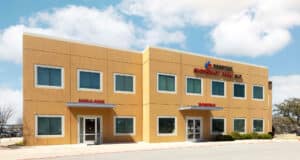Burn Treatment: Emergency Care and Recovery
Burns, no matter their severity, can be alarming and overwhelming. Knowing the right steps can help you heal more effectively and prevent complications like infection.
Keep reading to learn about the different types of burns, how to treat them, identify their severity, and when to seek emergency care.
Common Causes of Burns
Common causes of burns include heat, chemicals, electricity, and radiation.
Types of Burns
First-Degree Burns
A first-degree burn is a superficial burn that only affects the top layer of skin. These burns are usually red, dry, and painful but do not blister.
Sun exposure, scalds, or electricity commonly cause first-degree burns.
First-degree burn treatment
Here is how you can safely treat superficial burns at home:
- Cool the burn (e.g., cool water, a cold or wet compress).
- Apply petroleum jelly two or three times a day to keep the skin moist and promote healing.
- Cover the burn with a clean, non-stick dressing, gauze, or bandage.
- Take over-the-counter pain medication if needed.
- Avoid sun exposure.
Second-Degree Burns
A second-degree burn or partial-thickness burn affects the outer and underlying layers of skin. These burns are red, swollen, painful, and blistering. The skin may appear shiny and moist, and the layers may peel away as it heals.
Second-degree burns are commonly caused by direct contact with heat, electricity, chemicals, or friction. If your burn covers a large area of skin (e.g., more than three inches in diameter), shows signs of infection, or is located on the face, neck, hands, feet, groin, buttocks, or a major joint, seek immediate medical attention for treatment and to avoid further complications.
Second-degree burn treatment
Treatment may include:
- Cool water over the burn for 5-30 minutes reduces pain and prevents further damage.
- Gently clean the burn with mild soap and water to remove debris and lower your risk of infection.
- Cover the burn with a clean, non-stick dressing, gauze, or bandage.
- Take over-the-counter pain medication if needed.
- Visit your nearest emergency room for prompt, expert treatment.
Never apply ice, break blisters, or use butter, ointments, or pain-relief sprays on second-degree burns.
Third-Degree Burns
A third-degree or full-thickness burn involves all layers of skin, often including the underlying fat and muscle tissue. Your skin may appear stiff, waxy, white, leathery, or gray. These burns are severe and often require an urgent medical intervention, like skin grafting, to close the wound.
Steam, hot oil, grease, chemicals, electrical currents, and scalding liquids are common causes of third-degree burns. These burns carry a very high risk of infection and require treatment from a skilled medical professional as soon as possible to avoid complications.
Third-degree burn treatment
Prestige ER is skilled in burn treatment, including:
- Sterile burn cleaning to remove debris, dead skin, and tissue.
- Antibiotic ointment and proper wound dressing to keep your burn clean and dry and limit your risk of infection.
- Intravenous or oral antibiotics to prevent or clear an infection.
- Intravenous fluid replacement if your burn is large or severe to prevent shock.
- Pain relievers as needed.
- Skin grafting or reconstructive surgery to help your wound close and repair any severe damage.
Fourth-Degree Burns
Fourth-degree burns are the most severe and deepest burns. They can potentially be life-threatening and affect all layers of skin, along with the muscles, tendons, bones, and nerves.
Treatment for a fourth-degree burn is a medical emergency and requires immediate surgical intervention and emergency room services.
FAQs About Burn Treatment
What should I do first if I get burned?
If you have a severe fourth-degree burn covering a large area of skin, go to your nearest emergency room for life-saving care.
First-, second-and third-degree burns should be treated with cool running water for at least 10 minutes to cool the skin, remove debris, prevent further damage, and lower your risk of infection.
How can I heal a burn quickly?
If you have a mild to moderate burn that has been properly treated, keep your wound clean and dry to promote faster healing. It is also essential to follow your healthcare provider’s after-care instructions.
When should I go to the emergency room for a burn?
If you’ve sustained a burn that covers more than three inches in diameter or is covering the face, hands, feet, genitals, buttocks, or a major joint, go to your nearest emergency room for a thorough evaluation and prompt treatment to avoid further complications.
What are common mistakes to avoid when treating burns?
When treating burns:
- DO NOT apply ice directly to the burn.
- DO NOT break blisters.
- DO NOT apply butter or greasy substances.
- DO NOT attempt to remove clothing stuck to the burn.
- DO NOT soak the burn for too long.
- DO seek immediate medical attention for severe burns, especially those involving the face, hands, feet, genitals, buttocks, or a major joint.
Can burns leave permanent scars?
Yes. Burn scars are permanent but may fade over time. Treatments are available to help reduce the appearance of burn scars and improve skin flexibility. Once your burn is completely healed, talk to your primary healthcare provider to determine if scar reduction treatments are right for you.
Choose Prestige ER for Emergency Medical Care
Prestige Emergency Room provides rapid, reliable burn care and treatment for several other medical emergencies. We are a veteran-owned facility that provides personalized, expert care to you and your family 365 days a year, 24 hours a day. Find a location near you and visit us today.












